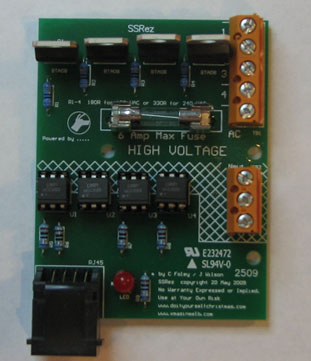SSRez

Why Another SSR?
Sean's SSRoz is a very good board. It is compact and functions great and without this inital work, the SSRez may not exist! However, it was not designed with a specific enclosure in mind. The intial move towards the SSRez involved changing the layout to fit the TA-200 Telephone Demarc Enclosure from YourBroadbandStore.com.
In order to keep the board to a min size, the SSRoz made all the neutral connections off board. So, take all the neutrals and connect them with a large wire nut (five 16AWG neutrals!) Once connected, where does the massive chuck of wire go? This lead to adding terminals for the neutrals...now this is not inexpensive. The cost was offset in part by removing the vertical fuseholder and replacing it with inexpensive fuse clips.
Lastly, the RJ45 connecter could be difficult to remove with the locking pin in a tight corner. A vertical RJ45 jack could make this so much easier.
While changing every thing around, the power traces were beefed up a bit to allow a slightly higher power throughput. This replaces the 5A fuse with a 7A one.
so....start out trying to change one problem..and end up with a whole new layout!
Disclaimers
The standard disclaimers apply to the SSRez and can be found here.
Schematic
Coming Soon
Bill of Materials
QTY Mouser #: Description 1 571-5556416-1 Modular Jacks 8 PCB TOP ENTRY 1 504-GMC-7 5mm x 20mm Medium Time Delay Fuses 125VAC 7A Med Time Delay 4 511-BTA04-700T Triacs 4 Amp 700 Volt 2 534-3517 Fuse Clips and Holders PC FUSE CLIP 5 MM 1 604-WP7104IT LED Standard HI EFF RED TRANS 5 660-CF1/4C681J 1/4Watt Axial Leaded Carbon Film Resistors 680ohms 5% 4 660-CF1/4C181J 1/4Watt Axial Leaded Carbon Film Resistors 180ohms 5% 4 859-MOC3023 Optocomponents Optocoupler TRIAC 4 571-1-390261-1 IC Sockets 6P ECONOMY TIN (optional!!) 5 538-39890-0302 Eurostyle Terminal Blocks 5.0MM ECONOMY 2P 14-24AWG
Construction Information
This is a work in Progress!!!
Oh, many of you will be building more than one SSRez at a time. An assembly line mindset really helps. This means, put all the resistors on all the boards before going to the next part.
Now, get your tools together! Cause here we we go.....
- Sort your parts in the order of assembly
- Check your resistors...make sure the part matches whats written on the bag.
- Inspect your boards for damage.
- Install the 5 680 Ohm Resistors. Bend them first to match the holes (I have been known to bend all my resistors while watching TV!) Insert them through the holes and bend the lead back to about 60 deg on both side to hold them in place. Solder each connection and trim off the excess lead with flush cut snips.
- Install the 4 180 Ohm Resistors for 120VAC operation or the 330 ohm resistors for 240VAC operation. The install process is the same as in Step #4
- Install the optional 6 pin sockets. Beware of the orientation of the notch. This is a visual aid to make sure that you put the MOCs in correctly. Match the notch with the notch in the silkscreen. Sometimes, a piece of tape can help here. I usually put all four on, cover them with a board and just flip it over. Solder the six pins on each socket. If you choose not to install the sockets, then install the 4 MOCs here in the same manner.
- Install the Power LED. Orientation is critical. The long leg of the LED must go into the square pad. Bend the legs out to a 60 deg angle to hold the LED in place. Then solder the leads and trim the excess.
- Now its time for the RJ45 Jack. The jack should snap into the 2 large mounting holes and hold itself in place. The pins are very small and solder very fast so be careful not to add too much solder.
- The 5 terminal blocks are next. The terminals must be assembled first. There is a notch and a pin on the side to mate the 5 parts into on long 10 position terminal. Once assembled, insert the block into the board. Starting from the middle and working outward, solder in all the pins. These pins are a bit larger and can take more heat and solder than the previous items.
- The fuse clips are next. Be ware the orientation of these as well. There is a small ridge inside the clip to keep the fuse from sliding out axially. This ridge must go to the side opposite the fuse. Using a fuse to hold the two clips in place while soldering has been suggested.
- Last, but not least, the TRIACs. These pins are large and they can be difficult to solder at first. If you have problems...tin the leads prior to inserting them into the boards.
Wiring
Coming Soon